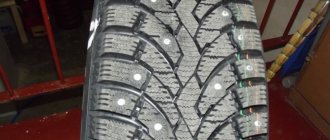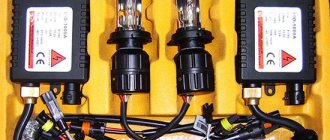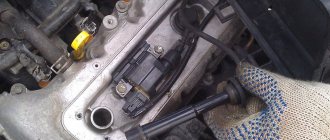A tire is not just rubber that softens the passage of uneven surfaces, but a functional design characterized by a complex structure. It ensures wheel traction on any road surface, effective braking and realizes the traction characteristics of the engine. Tires affect the vehicle's maneuverability, fuel consumption and the noise level created by the vehicle.
Wheel sizes of Lada Largus
The size of the wheels affects not only the appearance of the car, but also how it will behave on the road. AvtoVAZ indicates only one wheel size for the Lada Largus - 185/65 R15. Wheel parameters:
- 6Jx15;
- ET (departure) - 50;
- the distance between the holes for fasteners (bolt pattern) is 4x100.
Exactly the same size is indicated for Renault Logan, from which most of the components and parts for Largus were borrowed. In addition to this size, it is possible to install others:
When choosing, keep in mind that the wheel size should not differ significantly from the standard one. Installing larger rims and tires may negatively affect the operation of the ABS and ESP systems, and their calibration will be disrupted.
Acceleration and traction characteristics are affected by the weight of the wheels - the lower this value, the faster the car will accelerate and the better it will hold the road.
The situation is different with the Lada Largus Cross in the back of a van. This model is equipped with wheels with a radius of R16 from the factory; all other parameters (offset, bolt pattern) are the same.
Frequency of checking tire pressure
The tightness of the wheel structure is not ideal. The air gradually comes out. The reduction in pressure directly depends on the air temperature.
Monitoring must be regular. It is optimal to check your blood pressure at least twice a week. Ideal when leaving a parking lot, visiting a gas station, or performing maintenance.
The measurement should be carried out before the tires heat up (for example in the morning) in all wheels, even in the spare wheel. Checking along the way will not give accurate indicators.
The pressure in the tire should be lower than in the other wheels.
Visual assessment of the condition of tires is an irresponsible attitude towards the vehicle and safety. There is a high risk of not noticing a slight decrease or increase in pressure (0.1-0.5 atmospheres).
It must be remembered that temperature fluctuations and vehicle loading lead to changes in the indicator.
In the following situations, it is recommended to reduce the atmosphere to a level lower than the factory instructions:
- when driving on a slippery road (in winter);
- for off-road driving.
Selection of tires for Lada Largus
AvtoVAZ equips configurations above the base with Continental Premium Contact tires, but usually only for summer ones. For this reason, owners have a question about how to choose summer, winter or all-season tires for their car.
Selection of summer tires
Tires must match the wheel size. When choosing, the speed and weight index, brand and tread pattern are taken into account. The production date of the tires plays an important role - if they were made more than 5 years ago, it is better to refuse such a purchase.
Tread pattern
There are three types of patterns: asymmetrical, directional and symmetrical. The latter is the most popular, as it is considered universal and fits most cars. This is the best option for everyday driving around the city - without racing or off-road use. The main reason for choosing this design is its affordable price. Tires on Lada Largus with a symmetrical pattern are cheaper than all others. Such tires also have disadvantages - poor handling at high speed and wet asphalt, problems with sharp turns.
The directional tread pattern copes well with moderate off-road conditions and drains water well, showing normal handling and stability on wet road surfaces. The disadvantages include excessive noise, they cannot be placed on different sides due to strict direction, soft edges of the tread reduce directional stability.
The asymmetrical pattern shows the best characteristics: good directional stability, reduced risk of aquaplaning, you can swap wheels if necessary, increased controllability at high speed. The only drawback is the high price.
Profile height
If it is not possible to change the rims, it is recommended to install a standard tire size. Many owners strive to improve the appearance of their car. The most obvious way to do this is to install larger wheels, and this will require appropriate low-profile tires.
With a profile height of more than 60%, it is not advisable to use the car on the highway - such a tire is suitable for poor road surfaces and softens all unevenness. For driving on asphalt, it is better to use low-profile tires, as they improve dynamic performance and handling. But ride comfort is reduced - every bump will be reflected in the suspension.
Winter tires
When choosing winter tires, a lot depends on the budget, because there are European, Japanese, Chinese, and Russian brands on the market that produce tires in different price segments. For Lada Largus, it is recommended to use standard tires recommended by the manufacturer in winter. All that remains is to choose between studded and non-studded.
Other sizes
Some desperate owners strive to experiment in this area and install tires with different characteristics on their station wagons. Often people are prompted to do this by the desire to distinguish their “horse” from the gray mass of cars of the same type.
The most popular “experimental” size is “195x65xR15”. Much less often, owners install tires with dimensions “195x60xR15” or “205x60xR15”. Note that the space present inside the body arches allows the use of tires with other sizes:
- for “R16” wheels: “195x55xR16”, “195x60xR16” and “205x55xR16”;
- applicable to “R17” wheels: “205x45xR17”, “205x50xR17” and “225x45xR17”;
- with “R18” wheels: “215x35xR18” and “215x40xR18”.
Larger instances should be installed with extreme caution. Such “rollers” can lead to unpredictable changes in the behavior of a car on the road surface. This is especially pronounced in unfavorable weather.
How increasing the wheel size can affect the behavior of the car can be found in this table.
One should not discount the fact that increased sizes of wheels and tires can cause incorrect operation of the following systems responsible for active safety:
Replacing wheels on Lada Largus
There are many reasons why you have to remove one or more wheels. This is a simple puncture, replacing brake discs or pads, suspension repairs, changing tires. Every driver, regardless of length and experience, should be able to remove and install a disc on a hub. The procedure is simple and can be done with your own hands. To change a wheel on a Lada Largus you will need a standard set of tools:
- jack;
- wheel wrench, can be replaced with a wrench with a 17 mm head.
For safety reasons, work under a vehicle that is supported only by a jack is prohibited. It is advisable to play it safe and add bricks, timber spacers and other suitable devices.
Replacement process
Using a 17 mm socket, you need to unscrew the fastening bolt that secures the spare wheel in the niche. For factory decorative caps - installed on stamped discs - you will need a special key for removal; it is included in the standard tool kit. After removing the hubcap, you need to loosen the wheel bolts using a wheelbrace. Next, the car is jacked up, the wheel bolts are completely unscrewed, and the disc is removed. Installing a new wheel is carried out in the reverse order. Forged and alloy wheels use different bolts.
DIY tire replacement rules
In order to save money, many car enthusiasts are thinking about replacing tires themselves. The process is not the easiest, but doable. To work, you will need a balloon, mounting blades, a jack and a compressor or pump. When performing the procedure, you should take into account some tricks, without which this event is doomed to failure.
Removing the tire from the rim
First you need to remove the wheel from the hub. Then it is laid on the ground so that the nipple nipple is at the top. All the air is released from the tube or tire, in the case of a tubeless tire, and the nipple nipple is recessed inside. You need to stand on the wheel with your feet so that the edge of the tire separates from the rim of the disc. Sometimes extra force may be required if the rubber sticks to the metal.
A mounting blade is inserted into the gap between the edge of the tire and the disk, then a second one. The main task is to turn the sidewall of the tire beyond the edge of the rim. If the wheel has a tube, it is pulled out through the resulting gap. If the tire is tubeless, you need to unscrew the entire side of the tire by the rim, then unscrew the second sidewall of the tire using the same edge of the rim and remove it from the rim.
When working, you must apply considerable force and be careful not to damage the disc. Cast products made from light alloy materials are especially fragile.
Mounting a tire on a rim
Before installation, make sure that the tire is the correct size and has no defects. It is recommended to remove the balancing weights and the old nipple. When installing, you should take into account the markings on the tire, usually the direction of travel in the form of arrows.
To facilitate the installation task, you can apply a soap solution to the edge of the tire and the rim of the disk, but within reasonable limits, otherwise the tire will slip. Installation is carried out in the reverse order of removal. First, one edge of the tire is put on, after which the second one is wound on the rim.
Tire pressure and inflation
For wheels with a tube, everything is simple - you need to inflate the tube more than required in the manual (the pressure in Largus tires is no more than 2.1 atmospheres). This is necessary so that the tube sits evenly in the tire, after which you can deflate the air to the required values. For a tubeless tire the process is more complicated. When you try to inflate it, air will escape through the gap between the edge of the rim and the sidewalls of the tire.
You need to inflate any other wheel to 4 atmospheres. After this, remove the hose from the pump and put the end without a fitting on the nipple of the installed tire, the other end with a fitting is put on the inflated tire. Air under high pressure and at high speed will quickly fill an empty tire. This will be enough for it to sit tightly on the rim without having time to let air through the gaps. But it’s better to go to a tire shop, where this procedure will take a few minutes using special equipment. After the procedure, you will need to balance the wheels, which cannot be done in a garage without a machine.
Unlike all previous AvtoVAZ models, larger wheels are initially installed on Largus. This way, this model further emphasizes its relationship with other brands. Lada Largus is a joint product of AvtoVAZ and the Nissan-Renault concern.
Reading time: 4 minutes
The size of tires and wheels affects not only the vehicle's performance, but also its appearance. All designs indicate the corresponding parameters, which allow car owners to choose models for their vehicle. This review examines wheel sizes for the Lada Largus.
What non-standard sizes can be supplied?
Buy tires based on the full diameter of the wheel. It shouldn't be too different from the standard one.
Standard sizes allowed for installation.
| Model | Size, load capacity index | Center diameter wheel holes (DIA) | Radius between holes (PCD) | Number of nuts, pcs. | Wheel width, inches | Disc offset (ET) |
| R90 | 185/65R 15 88 H | 60,1 | 100 | 4 | 6J | 50 |
| F90 | 185/65R 15 92 H | 60,1 | 100 | 4 | 6J | 50 |
| CROSS | 205/55R 16 91 H | 60,1 | 100 | 4 | 5 ½, 6, 6 ½ J | 50 |
Attention. Replacing recommended sizes with acceptable ones will affect a number of characteristics. The dependence is shown in the table.
| Parameter | Increasing tire width | Increasing rim width |
| Keeping the car on the road | will improve | will improve |
| Accuracy of maintaining a given direction of movement | will improve | will improve |
| Road grip coefficient | will increase on dry roads | does not affect |
| Resistance to aquaplaning effect | will get worse | without changes |
| Traffic noise | will intensify | does not affect |
| Feelings when driving on rough roads | more comfortable | does not affect |
| Fuel consumption | will increase | will increase |
| Tire wear time | will speed up | without changes |
Be sure to calculate the load capacity index. Depending on the model, 88 (560 kg), 92 (630 kg) and 91 (615 kg) are allowed. The speed index is indicated next to the load capacity. T – up to 190 km/h, H – up to 210, V – up to 240.
An approximate formula will come in handy. Calculate the mass of the car, the weight of all possible passengers and cargo. Divide by 4 (wheels). Add a little extra.
Example: 1330 + 350 (passengers) + 170 (cargo) = 1850 / 4 = 462.5 kg + 40 = 502.5. In this case, a coefficient of 88 is acceptable. For summer tires, you will most likely need more.
Important! Installing large wheels can lead to incorrect operation of the ABS and electronic dynamic stabilization system of the vehicle.
The lighter the tires and wheels, the faster the vehicle accelerates. Thus, a car will accelerate to 100 km/h 0.2 seconds faster if the wheel weight is 2 kg less.
How to choose the right tire diameter
The choice of tires or wheels for the Lada Largus affects not only the external design of the car, but also the behavior of the vehicle on the roads. Car manufacturers indicate acceptable dimensions. Before installing the appropriate components, you need to familiarize yourself with the basic parameters. After all, replacement of products is carried out in order to improve driving performance.
The Largus instruction manual indicates only one acceptable size - 185/65 R15. Factories install stamped wheels on Largus 15 inches. In addition to the standard size declared by the manufacturer, car enthusiasts install 14-inch tires with a dimension of 185/70 R14. Among 15-inch tires, the tires chosen for Largus are 195/65 R15; 205/60 R15, 195/60 R15 are rare.
Which summer tires are best for Largus Cross cars?
When choosing, the speed and weight index, brand and tread pattern are taken into account. The production date of the products plays an important role - if they were made more than 5 years ago, it is better to refuse such a purchase.
The pattern is divided into two types: asymmetrical, directional and symmetrical. The last option is considered the most popular. Since the symmetrical pattern is suitable for most cars. This option is considered as the most convenient for moving around the city. The main reason for choosing this pattern is low cost.
The directional tread pattern allows car owners to drive off-road, providing ideal directional stability and handling. Unfortunately, there is some noise when driving off-road.
When replacing wheel structures, it is necessary to select standard models. When installing large components, you will have to choose the appropriate tires with a low profile. To move on a flat road, it is better to use low-profile tires. This tire improves dynamic performance and handling.
What size and wheel alignment angles for Lada Largus
Increasing the width of the products themselves will also have a positive effect on road holding, on the accuracy of car control, grip on dry roads will become better, and driving on uneven roads will become more comfortable. However, resistance to aquaplaning will deteriorate, noise will increase, fuel consumption will increase, and the tires will wear out faster.
On the Lada Largus the wheel parameters are as follows: 6×15/4×100 D60.1 ET50:
- width - 6 inches;
- bolt pattern - 4×100;
- standard diameter - 15 inches;
- diameter of the central hole - 60.1 mm;
- the offset is 50 mm.
Off-road version
In this modification, the Lada Largus station wagon is equipped with tires with dimensions “205x55xR16”. They are “put on” disks with the following parameters:
A tire is not just rubber that softens the passage of uneven surfaces, but a functional design characterized by a complex structure. It ensures wheel traction on any road surface, effective braking and realizes the traction characteristics of the engine. Tires affect the vehicle's maneuverability, fuel consumption and the noise level created by the vehicle.
About summer tires for Largus 185 65 R15
According to car owners, a tire from Renault Logan 5.5×14/4×100 D60.1 ET43 is ideal, but the Lada Largus will need a tire size with parameters 185/70 R14. Factory-assembled 16-inch Largus Cross alloy wheels. They have unique parameters: width is 6 inches, drilling is 4x100, offset is ET50, CO is D60.1. The declared size of parts for the Lada Cross corresponds to 205/65 R16 tires. AvtoVAZ supplies Continental Premium Contact tires with a low profile (55% of the width).
The smaller the unsprung mass (this includes the mass of tires and wheels), the better the car will hold the road and accelerate faster. For example, if you install wheels that are 2 kg lighter each, then acceleration to 100 km/h will be reduced to 0.2 seconds.
The LADA Largus Cross fits tires of the following sizes: 195/65 R15, 205/55 R16, 205/50 R17, 225/45 R17, with diameters: 15″, 16″, 17″. However, to obtain an accurate set of factory tire parameters, it is necessary to clarify the year and modification of the Lada Largus Cross engine.
Comparing summer tires 195/65R15 (Behind the Wheel)
At the end of March 2016, experts from another publication compared 12 sets of inexpensive tires from different brands.
Rating based on the results of all tests:
- Nokian Hakka Green 2
- Goodyear Efficientgrip Performance
- Amtel Planet Evo
- Toyo Proxes CF2
- Nordman SX
- Continental Contipremium contact 5
- Yokohama Bluearth AE-01
- Cordiant Sport 3
- Hankook Kinergy Eco
- Bridgestone Turanza T001
- Michelin Energy XM2
- Kumho Ecowing ES01
Rating of the quietest tires for summer:
- Hankook Kinergy Eco and Toyo Proxes CF2
- Amtel Planet Evo, Goodyear Efficientgrip Performance, Nordman SX, Bridgestone Turanza T001 and Michelin Energy XM2
- Hankook Kinergy Eco, Cordiant Sport 3, Yokohama Bluearth AE-01 and Continental Contipremiumcontact 5
- Kumho Ecowing ES01











